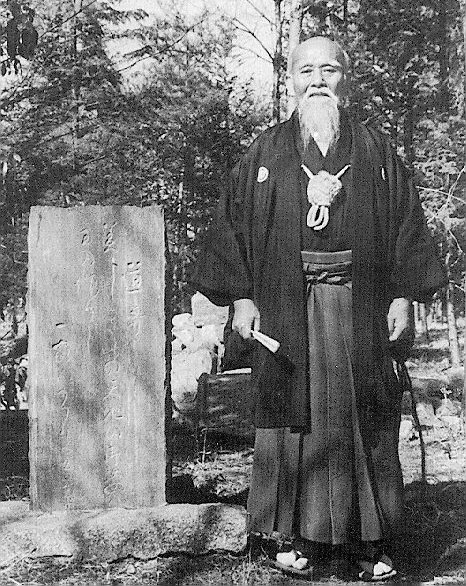Training schedule
|
MORIHEI UESHIBA
His first fighting experience was when his father was teaching him the secret style named Aiai-ryu. Since 1890 he attended to a religious school Jizodera, where he learned reading and writing, studied Confucianism and Buddhism Shingon, also practiced swimming and sumo wrestling. After graduating, he had studied in an economical school and became a civil servant. After taking part in a political manifestation, he resigned from office. In the 1902 he set off to Tokyo and started to trade writing materials. It was then he started his serious education with martial arts. At first Kito-ryu jujitsu of master Tozawa Tokosaburo and Yagryu-Shinkage-ryu (sword fighting), which was famous for using almost 2000 techniques with every kind of weapons. Ueshiba quickly understood the essence of hand-to-hand combat efficiency, and became stronger and tougher. In 1908 he received the diploma and the title of master, signed by an Yagyu-ryu expert Nakasatsu Nakai, with outstanding abilities of using a sword and a spear. Ueshiba was, at that time, strong and exercised: he was doing weight-lifting, and training with the yari spear and katana sword allowed him to fight with many opponents. Full of life, inspired by the nationalism ideology, young Ueshiba took part in war between Japan and Russia. Hiding from the bullets on one of the rice fields in Manchuria, seeing the power of death, losing his friends due to an order of a newbie officer, he suffered a psychical shock. In peace he had found hope of starting a new life. Unfortunately he was struck with ber-beri (meningitis) and was near death for half of the year. Then he came back to Japan, where he married Hatsu Itokawa. The doctors advised Ueshiba to lead a life close to nature, so 27 years old Ueshiba with a group of colonists settled a small village in Shirataki wilderness on Hokkaido. There he met the famous Sokaku Terada from the aikijujutsu – Daito-ryu school. Takeda had enormous respect, because despite his small posture, he had great stamina which was a triumph over the nature. Master Takeda explained that his power comes from being the guardian of the pureness of Daito Ryu tradition record, the honour and privilege of the family from many generations. Takeda was a harsh teacher. He demanded 300 yens for every taught technique and the only way to earn it was to work on a field barely snatched away from the forest. Its protection required a lot of effort plus there was also the work on the masters “field”. So his student usually trained alone. Ueshiba mentioned that Takeda during 5 years period, devoted to him only one hundred days , but this way of teaching, melted in the nature, was natural and permanent. After a couple of years he received his Daito-Ryu master diploma. In 1919, because of his father illness, Morihei Ueshiba had left the village and set off to a long journey. During it, he met a mystic from a new sect Omoto-kyo, called Onisaburo Deiguchi. Deguchi combined together affection for nature with Chinese motives of Taoism. Ueshiba was under an impression of the priests personality and, after the funeral of his father, he had returned to the mountain Ayabe, to meditate the teachings of the famous healer and master in a martial arts way. He intensively trained the forms of bujutsu, in solitude and with no rush approach to its deepest essence- the source of energy. One night, he saw the central truth, which bind everything. Afterwards he claimed in the zen language that he experienced revelation – satori. Very painful was to him the information of death of his two sons: 3 years old Takemori, and 1 year old Kuniharu. Despite the hard times (in 1921 to profess the Omoto religion was a crime plus the arrest of Deguchi) dojo of O’Sensei was developing, and he, for the first time cutting off from the old martial arts, and creating Aikijujutsu. In 1924 Morihei Ueshiba with Deguchi, being released from prison, set off to a journey to Manchuria and Mongolia, in place of the Japanese – Chinese conflict. They tried to create an “army of peace” from the both forces. Ueshiba was arrested although, due to the intervention of the ambassador was set free, and the press called him “The Japanese Gandhi”. During his mission, he met many Japanese budo experts. His demonstrations caught the eye of Admiral Takeshita, a judo master (5 dan), who invited him to Tokio. There Ueshiba gathered a group of students with a lot of experience in different budo and bujutsu disciplines. He called his art Ai-Ki-Do (Aikido), and its meaning was explained as “The Way(Do) of Harmony (Ai) and Energy(Ki)”. Ueshiba has earned respect with his radical proclamation of love and peace during the times when chauvinism and aggressive expansion of Japan were the main slogans. Great masters of different budo schools saw Ueshiba’s both noble character and enormous talent for reconstructing the essence of the art of budo. Jigoro Kano (the creator of Judo) not only paid Ueshiba a visit, but also brought to him talented judo apprentices: Nagoka, future 10th dan in judo, Tomiki (8th dan in judo), Tokeda (4th dan in judo) and Mozuchki (4th dan in judo). The full demonstration of his agility O’Sensei Morihei Ueshiba came back to the source |






